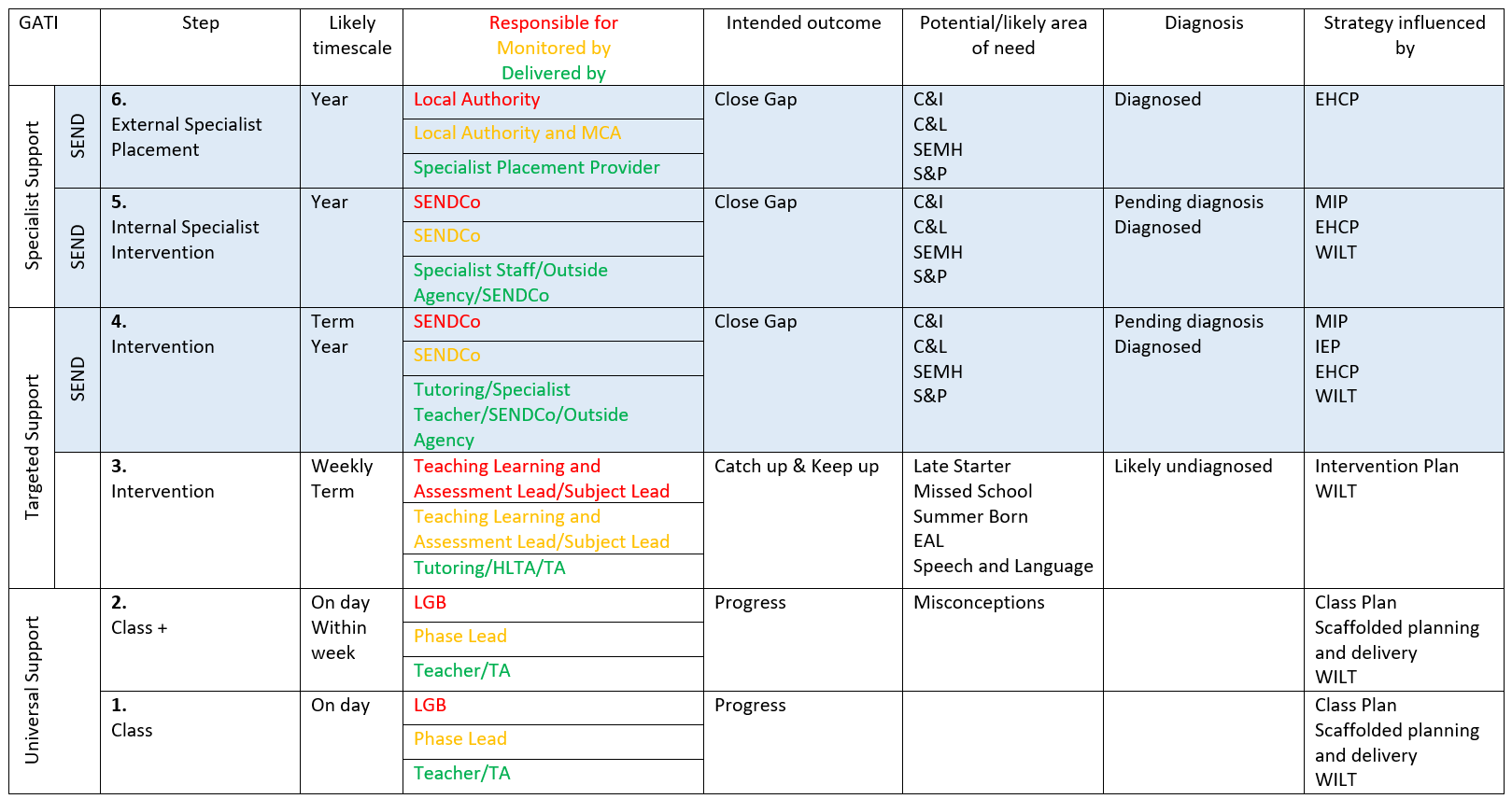Curriculum Steps of Strategic Support (SEND)
SEND at Mayflower Community Academy
At Mayflower Community Academy we recognise that our pupils have an array of needs. We therefore, think carefully about the design and layout of our curriculum, resources and environment in order to meet these needs.
We work to the following principles: consistency, predictability, routine, boundaries, self-regulation, modelling and the belief that everyone can learn. Our goals are to identify pupils’ needs and then establish and support their route to academic learning.
In order to support staff, pupils and their families, we have developed the Six Steps of Strategic Support (in conjunction with the Local Authorities Graduated Approach to Inclusion).
Guide to support for pupils with SEND
Our purpose is to enable pupils to thrive in school and meet their full potential. However, all pupils have differing strengths and needs and therefore, different levels of support maybe required.
Steps of Strategic Support
We have developed the Steps of Strategic Support which include the following and instruct our practice.

Step 1
Step 1 incorporates the Universal Provision of High Quality Teaching for all pupils. Assessment of need is through class based formative and summative assessment. Personalisation needs are identified and provided through models, images and manipulatives. Evidence of understanding and need is identified through questioning and outcomes and is recorded through planning and personalisation plans.
Step 2
Step 2 incorporates the Universal Provision of High Quality Teaching for all pupils but addresses any misconceptions at the source of the issue. Assessment of need is through class based formative and summative assessment using questioning and tools such as the Misconception Memos. Misconceptions can then be targeted during the lesson by the teacher or TA, after the lesson through spaced practice or if not recognised at source they will be recognised through the outcomes in books and a plan will be put in place to address the issue.
All teaching staff firstly adopt the Access for All approach which includes Steps 1 and 2 of the Steps of Strategic Support. Here, they look closely at how they adapt and deliver their teaching and environment to ensure pupils can access learning. This highlights the needs of the pupils.
Step 3
Step 3 incorporates Additional Intervention for the pupils. At this stage this is a time limited intervention of up to 6 weeks. Through Teacher assessment and data Teachers, Phase Leads and Subject Leads will determine who requires further intervention. This will be led by the Teacher or Teaching Assistant and takes place before, during or after school. If it is determined that a time limited intervention from an Outside Agency is required such as Speech and Language then a consultation with the SENDCo will take place and a referral sent.
Step 4
Step 4 moves to Targeted Intervention within school. At this point further assessment and planning of support may be required for the pupil. A consultation with the SENDCO and SEN Team can take place and the relevant assessments/referrals can be completed. This now leads to the pupils having an SEND Support Plan. This includes the Mayflower Inclusion Plan which also incorporates an Individual Education Plan (IEP), if this is deemed relevant.
The SEND Support Plan has been introduced this academic year. The IEP leads to more inclusive and personalised support. Teachers use the Graduated Approach to Learning to identify key areas of need within the 4 areas as set out in the SEND Code of Practice. These include Communication and Interaction, Cognition and Learning, Social, Emotional and Mental Health and Sensory and Physical. Using these Key indicators as the overarching target for a pupil to work towards ensures that it is purposeful, as it has been identified through research by professionals. These targets can then be broken down into smaller steps which can be incorporated into the pupil’s provision through personalisation, scaffolding, intervention, specialist teaching or outside agency support.
Outside Agency support, if deemed to be ongoing, may then lead to a Team around me (TAM) or Early Help Assessment Tool (EHAT) which would move the pupil to Step 5.
Step 5
Step 5 incorporates Internal Specialist Provision and support from Outside Agencies which is foreseen to be long term. This will include focused support and targets and the development of a TAM or EHAT with assessment/advice and support from Staff, parents and Outside Agencies. This could include an Education Health and Care Plan. A diagnosis may be pending or have been received. If it is determined that a higher level of support is required that is unable to met in a mainstream classroom then the pupil will move to Step 6.
Step 6
Step 6 is the final step when all levels of support have been trialled and assessed. At this step the pupil will have moved to a Specialist Provision in order to meet their needs.
